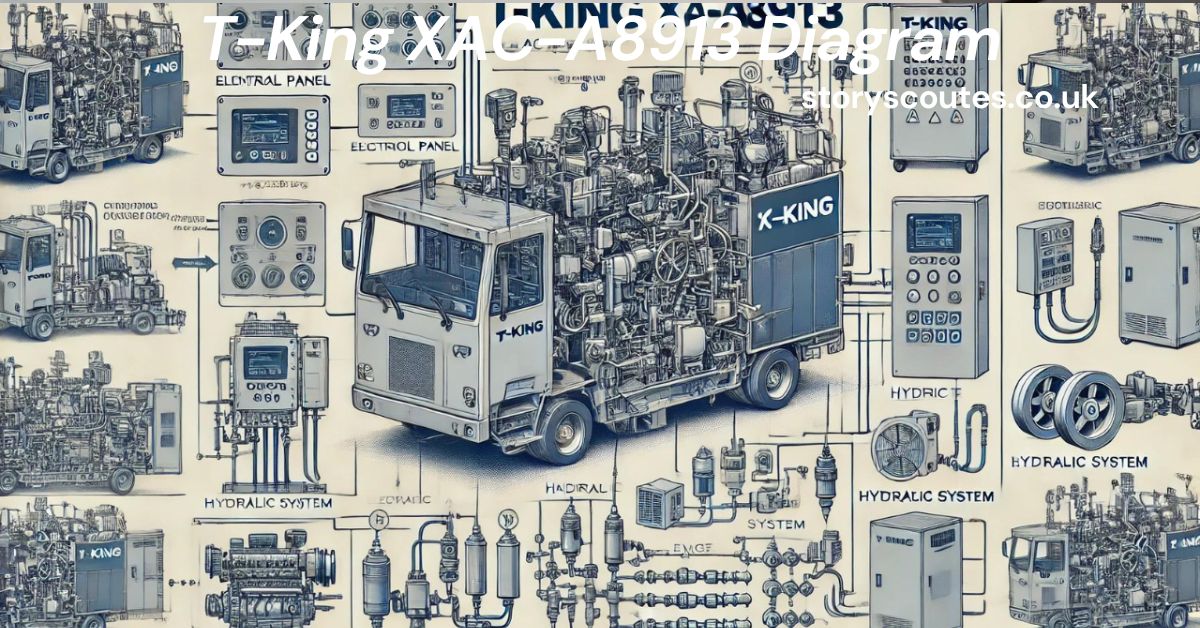T-King XAC-A8913 Diagram: The Ultimate Guide to Understanding
Are you struggling to make sense of the T-King XAC-A8913 diagram? You’re not alone. This comprehensive guide will break down everything you need to know about this important vehicle schematic. Whether you’re a DIY enthusiast or a professional mechanic, understanding the T-King XAC-A8913 diagram is crucial for maintaining and repairing your vehicle. Let’s dive in and explore this diagram in detail.
What is the T-King XAC-A8913 Diagram?
The T-King XAC-A8913 diagram is a detailed schematic that provides essential information about the layout, components, and wiring of a specific vehicle model. This diagram is an invaluable resource for anyone working on or maintaining a T-King XAC-A8913 vehicle.
Key Features of the T-King XAC-A8913 Diagram:
- Comprehensive vehicle layout
- Detailed component illustrations
- Complete wiring schematics
- Color-coded sections for easy reference
- Part numbers and specifications
Why is the T-King XAC-A8913 Diagram Important?
Understanding the T-King XAC-A8913 diagram is crucial for several reasons:
- Accurate Repairs: The diagram helps ensure that repairs are done correctly by showing the exact location and connections of various components.
- Time-Saving: With a clear diagram, you can quickly identify parts and their relationships, saving time during maintenance and repairs.
- Troubleshooting: When problems arise, the diagram serves as a roadmap to help you pinpoint potential issues.
- Safety: Proper understanding of the electrical system helps prevent accidents and ensure safe operation of the vehicle.
- Cost-Effective: By referring to the diagram, you can avoid costly mistakes and unnecessary part replacements.
Breaking Down the T-King XAC-A8913 Diagram
Let’s explore the main sections of the T-King XAC-A8913 diagram to help you navigate it more effectively.
1. Engine Bay Layout
The engine bay section of the T-King XAC-A8913 diagram provides a detailed view of the components under the hood. This includes:
- Engine block
- Alternator
- Battery
- Radiator
- Air intake system
- Fuel system components
Understanding this section helps you locate parts quickly during maintenance and troubleshooting.
2. Electrical System
The electrical system is a critical part of the T-King XAC-A8913 diagram. It shows:
- Battery connections
- Fuse box layout
- Wiring harness routes
- Electrical component locations
This section is essential for diagnosing electrical issues and ensuring proper connections during repairs.
3. Suspension and Steering
The suspension and steering section of the T-King XAC-A8913 diagram outlines:
- Shock absorbers
- Springs
- Steering column
- Tie rods
- Control arms
This information is crucial for alignment work and suspension repairs.
4. Brake System
The brake system layout in the T-King XAC-A8913 diagram includes:
- Brake lines
- Master cylinder
- Brake calipers
- Rotors
- ABS components (if applicable)
Referring to this section ensures proper brake system maintenance and repair.
5. Fuel System
The fuel system portion of the T-King XAC-A8913 diagram shows:
- Fuel tank
- Fuel lines
- Fuel pump
- Fuel injectors
- Carburetor (for older models)
This section is vital for addressing fuel delivery issues and performing fuel system maintenance.
6. Exhaust System
The exhaust system layout in the T-King XAC-A8913 diagram includes:
- Exhaust manifold
- Catalytic converter
- Muffler
- Exhaust pipes
Understanding this section helps with emissions-related repairs and exhaust system maintenance.
7. Transmission
The transmission section of the T-King XAC-A8913 diagram outlines:
- Transmission case
- Gears
- Clutch (for manual transmissions)
- Torque converter (for automatic transmissions)
This information is crucial for transmission repairs and maintenance.
How to Read the T-King XAC-A8913 Diagram
Reading the T-King XAC-A8913 diagram may seem daunting at first, but with a few tips, you’ll be navigating it like a pro:
- Familiarize yourself with symbols: The diagram uses standard symbols to represent different components. Learn these symbols to understand what you’re looking at quickly.
- Follow the lines: Wiring and connections are represented by lines. Follow these lines to understand how components are connected.
- Use the legend: The diagram should include a legend that explains what different colors, line types, and symbols mean. Refer to this often.
- Start with major components: Begin by identifying major components like the engine, transmission, and battery. This will help you orient yourself within the diagram.
- Work in sections: Don’t try to understand the entire diagram at once. Focus on one system or section at a time.
- Cross-reference with your vehicle: As you study the diagram, look at your actual vehicle to make connections between the schematic and real-world components.
Common Applications of the T-King XAC-A8913 Diagram
The T-King XAC-A8913 diagram is useful in various situations:
- Routine Maintenance: Use the diagram to locate components that require regular service, such as filters, belts, and fluids.
- Troubleshooting: When your vehicle has issues, the diagram can help you trace systems to identify potential problems.
- Parts Replacement: The diagram provides part numbers and locations, making it easier to find and replace specific components.
- Upgrades and Modifications: If you’re planning to modify your vehicle, the diagram helps you understand how new components will integrate with existing systems.
- Electrical Work: For any electrical repairs or upgrades, the wiring schematics in the diagram are invaluable.
Tips for Using the T-King XAC-A8913 Diagram Effectively
To get the most out of your T-King XAC-A8913 diagram:
- Keep it clean and accessible: Store your diagram in a clean, dry place where you can easily refer to it while working.
- Make notes: As you work on your vehicle, make notes on your diagram about specific repairs or modifications you’ve made.
- Use in conjunction with the manual: The T-King XAC-A8913 diagram works best when used alongside your vehicle’s service manual.
- Digital copy: If possible, keep a digital copy of the diagram on your phone or tablet for easy reference.
- Color code: Use highlighters to color-code different systems on your diagram for quick reference.
- Practice: The more you use the diagram, the better you’ll become at reading and understanding it.
The History and Evolution of the T-King XAC-A8913 Diagram
Understanding the history of the T-King XAC-A8913 diagram can provide valuable context:
- Early versions: The first T-King XAC-A8913 diagrams were simple black and white sketches with basic component layouts.
- Technological advancements: As vehicles became more complex, so did the diagrams. Color coding and more detailed schematics were introduced.
- Digital era: Modern T-King XAC-A8913 diagrams are often available in digital formats, allowing for zooming and easy searching.
- Continuous updates: As the T-King XAC-A8913 vehicle model evolves, the diagram is updated to reflect new components and systems.
Comparing the T-King XAC-A8913 Diagram to Other Vehicle Diagrams
While the T-King XAC-A8913 diagram is specific to its model, it shares similarities with other vehicle diagrams:
- Standardized symbols: Many symbols used in the T-King XAC-A8913 diagram are industry standard, making it easier to transition between different vehicle diagrams.
- Layout differences: Each vehicle model has a unique layout, so while the general principles are the same, the specific arrangements will differ.
- Complexity variations: The T-King XAC-A8913 diagram may be more or less complex than other vehicle diagrams, depending on the vehicle’s features and systems.
- Brand-specific elements: Some aspects of the T-King XAC-A8913 diagram may be unique to the T-King brand, reflecting their specific engineering choices.
The Future of Vehicle Diagrams Like the T-King XAC-A8913
As technology advances, we can expect vehicle diagrams, including the T-King XAC-A8913, to evolve:
- Interactive digital formats: Future diagrams may be fully interactive, allowing users to click on components for more information.
- 3D modeling: Advanced 3D models could replace 2D diagrams, providing a more realistic representation of the vehicle.
- Augmented reality integration: AR technology could overlay diagram information onto the actual vehicle, making repairs and maintenance more intuitive.
- Real-time updates: As vehicles become more connected, diagrams could potentially update in real-time to reflect the current state of the vehicle.
- AI assistance: Artificial intelligence could help interpret diagrams and provide guidance for repairs and maintenance.
Common Mistakes When Using the T-King XAC-A8913 Diagram
Even experienced mechanics can make mistakes when using the T-King XAC-A8913 diagram. Here are some common pitfalls to avoid:
- Misinterpreting symbols: Always double-check the meaning of symbols in the legend to avoid confusion.
- Overlooking updates: Make sure you’re using the most recent version of the diagram, as outdated information can lead to errors.
- Ignoring color codes: The color coding in the T-King XAC-A8913 diagram is there for a reason. Pay attention to it for easier navigation.
- Assuming all models are identical: Even within the T-King XAC-A8913 line, there may be slight variations. Always verify that your diagram matches your specific vehicle.
- Neglecting to cross-reference: While the diagram is a powerful tool, it’s always best to cross-reference with the actual vehicle and service manual.
Resources for Further Learning About the T-King XAC-A8913 Diagram
If you want to deepen your understanding of the T-King XAC-A8913 diagram, consider these resources:
- T-King official website: Often provides detailed information and possibly digital versions of the diagram.
- Online forums: Connect with other T-King XAC-A8913 owners to share experiences and tips.
- YouTube tutorials: Many mechanics and DIY enthusiasts create helpful videos explaining vehicle diagrams.
- Local libraries: May have copies of detailed vehicle repair manuals that include comprehensive diagrams.
- Professional mechanics: Consider taking a class or workshop on reading vehicle diagrams.
Conclusion: Mastering the T-King XAC-A8913 Diagram
Understanding the T-King XAC-A8913 diagram is a valuable skill that can save you time, money, and frustration when maintaining or repairing your vehicle. By familiarizing yourself with the layout, symbols, and systems represented in the diagram, you’ll be better equipped to tackle a wide range of automotive tasks.
Remember, the diagram is a tool, and like any tool, it becomes more effective the more you use it. Don’t be discouraged if it seems complex at first – with practice and patience, you’ll soon be navigating the T-King XAC-A8913 diagram with confidence.
Whether you’re a DIY enthusiast or a professional mechanic, mastering this diagram will undoubtedly enhance your ability to work on your T-King XAC-A8913 vehicle. So, keep this guide handy, refer to it often, and happy wrenching!
Frequently Asked Questions (FAQs)
What is the T-King XAC-A8913 diagram?
The T-King XAC-A8913 diagram is a detailed schematic that shows the layout, components, and wiring of the T-King XAC-A8913 vehicle model. It’s an essential tool for maintenance and repairs.
Where can I find the T-King XAC-A8913 diagram?
You can usually find the diagram in the vehicle’s service manual, on the T-King official website, or through authorized T-King dealers.
Do I need special training to read the T-King XAC-A8913 diagram?
While special training isn’t necessary, familiarity with basic automotive concepts and symbols will make it easier to understand the diagram.
Can I use the T-King XAC-A8913 diagram for other vehicle models?
The diagram is specific to the T-King XAC-A8913 model. While some general principles may apply, it’s best to use the correct diagram for each vehicle model.
How often is the T-King XAC-A8913 diagram updated?
Updates to the diagram typically occur when significant changes are made to the vehicle model. Always ensure you’re using the most recent version for your specific vehicle year.
Is the T-King XAC-A8913 diagram available in digital format?
Many modern vehicle diagrams, including the T-King XAC-A8913, are available in digital formats. Check with T-King or authorized dealers for digital options.
What should I do if I can’t understand a part of the T-King XAC-A8913 diagram?
If you’re having trouble understanding the diagram, consult the vehicle’s service manual, seek help from online forums dedicated to T-King vehicles, or consult a professional mechanic.
Can the T-King XAC-A8913 diagram help me with DIY repairs?
Yes, the diagram is an excellent resource for DIY repairs. It can help you locate components, understand systems, and follow proper repair procedures.
Are there color codes in the T-King XAC-A8913 diagram?
Yes, most modern vehicle diagrams, including the T-King XAC-A8913, use color coding to differentiate between various systems and components.
How does the T-King XAC-A8913 diagram compare to other vehicle diagrams?
While the basic principles are similar, each vehicle model has its unique diagram. The T-King XAC-A8913 diagram is specifically tailored to that model’s layout and systems.






